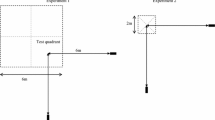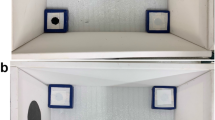Abstract
Recent work on captive flying squirrels has demonstrated a novel degree of flexibility in the use of different orientation cues. In the present study, we examine to what extent this flexibility is present in a free-ranging population of another tree squirrel species, the fox squirrel. We trained squirrels to a rewarded location within a square array of four feeders and then tested them on transformations of the array that either pitted two cue types against one cue type, the majority tests, or all cue types against each other, the forced-hierarchy test. In Experiment 1, squirrels reoriented to the two-cue-type location in all majority tests and to the location indicated by the visual features of the feeders in the forced-hierarchy test. This preference for visual features runs contrary to previous studies that report the use of spatial cues over visual features in food-storing species. In Experiments 2–5 we tested squirrels with different trial orders (Experiments 2 and 3), a different apparatus (Experiment 4) and at different times of the year (Experiment 5) to determine why these squirrels had chosen to orient using visual features in the first experiment. Like captive flying squirrels, free-ranging fox squirrels showed a large degree of flexibility in their use of cues. Furthermore, their cue use appeared to be sensitive both to changes in the test apparatus and the season in which we tested. Altogether our results suggest that the study of free-ranging animals over a variety of conditions is necessary for understanding spatial cognition.



Similar content being viewed by others
References
Able KP (1993) Orientation cues used by migratory birds: a review of cue-conflict experiments. Trends Ecol Evol 8:367–371
Brodbeck DR (1994) Memory for spatial and local cues: a comparison of a storing and a nonstoring species. Anim Learn Behav 22:119–133
Byrne S (1979) The distribution and ecology of the non-native tree squirrels, Sciurus carolinensis and Sciurus niger, in northern california. Ph.D. Dissertation, University of California, Berkeley
Cahalane VH (1942) Caching and recovery of food by the western fox squirrel. J Wildl Manage 6:338–352
Chang Q, Gold PE (2003) Switching memory systems during learning: changes in patterns of brain acetylcholine release in the hippocampus and striatum in rats. J Neurosci 23:3001–3005
Chavarriaga R, Strosslin T, Sheynikhovich D, Gerstner W (2005) Competition between cue response and place response: a model of rat navigation behaviour. Connect Sci 17:167–183
Cheng K, Shettleworth S, Huttenlocher J, Rieser J (2007) Bayesian integration of spatial information. Psychol Bull 133:625–637
Clayton NS, Krebs JR (1994) Memory for spatial and object-specific cues in food-storing and nonstoring birds. J Comp Physiol A Sens Neuroethol Neural Behav Physiol 174:371–379
Devenport JA, Luna LD, Devenport LD (2000) Placement, retrieval, and memory of caches by thirteen-lined ground squirrels. Ethology 106:171–183
Dyer FC, Seeley TD (1994) Colony migration in the tropical honey-bee Apis dorsata (Hymenoptera, Apidae). Insectes Soc 41:129–140
Galea LAM, Kavaliers M, Ossenkopp KP, Innes D, Hargreaves EL (1994) Sexually dimorphic spatial-learning varies seasonally in 2 populations of deer mice. Brain Res 635:18–26
Gaulin SJC, Fitzgerald RW, Wartell MS (1990) Sex-differences in spatial ability and activity in 2 vole species (Microtus ochrogaster and Microtus pennsylvanicus). J Comp Psychol 104:88–93
Gibbs SE, Lea SE, Jacobs LF (2007) Flexible use of spatial cues in the southern flying squirrel (Glaucomys volans). Anim Cogn 10:203–209
Healy SD, Hurly TA (1998) Rufous hummingbirds’ (Selasphorus rufus) memory for flowers: patterns or actual spatial locations? J Exp Psychol Anim Behav Process 24:396–404
Herz RS, Zanette L, Sherry DF (1994) Spatial cues for cache retrieval by black-capped chickadees. Anim Behav 48:343–351
Hodgson ZG, Healy SD (2005) Preference for spatial cues in a non-storing songbird species. Anim Cogn 8:211–214
Hurly TA, Healy SD (1996) Memory for flowers in rufous hummingbirds: location or local visual cues? Anim Behav 51:1149–1157
Jacobs LF (1996) The economy of winter: phenotypic plasticity in behavior and brain structure. Biol Bull 191:92–100
Jacobs LF, Liman ER (1991) Gray squirrels remember the locations of buried nuts. Anim Behav 41:103–110
Jacobs LF, Shiflett MW (1999) Spatial orientation on a vertical maze in free-ranging fox squirrels (Sciurus niger). J Comp Psychol 113:116–127
Jacobs LF, Schenk F (2003) Unpacking the cognitive map: the parallel map theory of hippocampal function. Psychol Rev 110:285–315
Kemp A, Manahan-Vaughan D (2007) Hippocampal long-term depression: Master or minion in declarative memory processes? Trends Neurosci 30:111–118
Kemp A, Manahan-Vaughan D (2008) The hippocampal CA1 region and dentate gyrus differentiate between environmental and spatial feature encoding through long-term depression. Cereb Cortex 4:968–977
King J (2004) The current distribution of the introduced fox squirrel (Sciurus niger) in the greater Los Angeles metropolitan area and its behavioral interaction with the native western gray squirrel (Sciurus griseus). M.S. thesis, University of California, Los Angeles
Lavenex P, Shiflett MW, Lee RK, Jacobs LF (1998) Spatial versus nonspatial relational learning in free-ranging fox squirrels (Sciurus niger). J Comp Psychol 112:127–136
Lavenex P, Steele MA, Jacobs LF (2000) Sex differences, but no seasonal variations in the hippocampus of food-caching squirrels: a stereological study. J Comp Neurol 425:152–166
Macdonald IMV (1997) Field experiments on duration and precision of grey and red squirrel spatial memory. Anim Behav 54:879–891
Packard MG, McGaugh JL (1996) Inactivation of hippocampus or caudate nucleus with lidocaine differentially affects expression of place and response learning. Neurobiol Learn Mem 65:65–72
Padgett K, Reisen WK, Kahl-Purcell N, Fang Y, Cahoon-Young B, Carney R, Anderson N, Zucca L, Woods L, Husted S, Kramer V (2007) West nile virus infection in tree squirrels (Rodentia: Sciuridae) in California, 2004–2005. Am J Trop Med Hyg 76:810–813
Phillips JB, Moore FR (1992) Calibration of the sun compass by sunset polarized-light patterns in a migratory bird. Behav Ecol Sociobiol 31:189–193
Pyter LM, Trainor BC, Nelson RJ (2006) Testosterone and photoperiod interact to affect spatial learning and memory in adult male white-footed mice (Peromyscus leucopus). Eur J Neurosci 23:3056–3062
Schöne H (1984) Spatial orientation: the spatial control of behavior in animals and man. Princeton University Press, Princeton
Sherry DF, Duff SJ (1996) Behavioural and neural bases of orientation in food-storing birds. J Exp Biol 199:165–171
Spetch ML, Edwards CA (1988) Pigeons, Columba livia, use of global and local cues for spatial memory. Anim Behav 36:293–296
Stapanian MA, Smith CC (1978) A model for seed scatterhoarding: coevolution of fox squirrels and black walnuts. Ecology 59:884–896
Thiele J, Winter Y (2005) Hierarchical strategy for relocating food targets in flower bats: spatial memory versus cue-directed search. Anim Behav 69:315–327
Vlasak AN (2006a) The relative importance of global and local landmarks in navigation by columbian ground squirrels (Spermophilus columbianus). J Comp Psychol 120:131–138
Vlasak AN (2006b) Global and local spatial landmarks: Their role during foraging by columbian ground squirrels (Spermophilus columbianus). Anim Cogn 9:71–80
Watanabe S (2005) Strategies of spatial learning for food storing in scrub jays. Ethology 23:181–187
Acknowledgments
We would like to thank José Lopez and Ted Claire for constructing the feeders, Stephen Lea and participants from Berkeley Behavior Lunch and Comparative Cognition Tea for constructive comments on the manuscript. We would also like to thank Cindy Lau for her help in collecting the data. The research was supported by a grant from the University Committee on Research and by a sabbatical appointment to L.J. at the Santa Fe Institute. The research followed federal and university animal care and use rules and guidelines and complied with APA ethical standards in the treatment of animals.
Author information
Authors and Affiliations
Corresponding author
Rights and permissions
About this article
Cite this article
Waisman, A.S., Jacobs, L.F. Flexibility of cue use in the fox squirrel (Sciurus niger). Anim Cogn 11, 625–636 (2008). https://doi.org/10.1007/s10071-008-0152-5
Received:
Revised:
Accepted:
Published:
Issue Date:
DOI: https://doi.org/10.1007/s10071-008-0152-5




